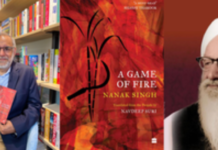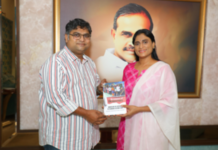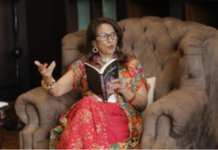By Vishnu Makhijani
New Delhi– Hampi-based curator Lavina Baldota conceptualised eSantati four years ago as a tribute to Mahatma Gandhi on his 151st birth anniversary. “The idea that started with textile art, eKhadi A Canvas, by Gaurang Shah expanded to involving art and design minds from various disciplines along with collections from different museums – each interpreting their Gandhi,” Baldota said.
Twelve other individuals and institutions eventually came on board. The exhibition opened at Mumbai’s NGMA, on October 2 last year and subsequently moved to New Delhi’s Kasturbhai Lalbhai Museum, New Delhi’s IGNCA and to Hyderabad’s Saptaparni, is now headed for Vadodara. It has now been immortalised in a coffee table book, also titled eSantati’ (HarperCollins) for which New Delhi-based poet and mixed media artist Navkirat Sodhi has woven its strands together with some soul-tugging verses which, if set to music, could well spawn a new genre in the eRaghupati Raghav Raja Ram’ style.
“Personally, for me, the journey has led to self enquiry, shedding of the unnecessary and a humble realization that I have a very long way to go.
To quote Navkirat, ekeep walking till you know this journey knows no end’,” Baldota, whose father was closely association with Mahatma Gandhi during the freedom movement, told IANS in an email interview.
Sodhi couldn’t agree more. “Spiritually, it has been a journey of letting go of unnecessary mental shackles and transferring all energy into constructive, creative, faith-filled action,” she told IANS.
“Since the book is about the relevance of Mahatma Gandhi’s messages then, now and next e this process has reaffirmed my belief in simple living, high thinking. It has shown me how poignant and infinite his ideas remain for a world grappling with the consequences of its collective action,” Sodhi added.
“The power of the Mahatma is such that everyone involved in Santati, whether it’s the curator, the artists, the artisans, the collectors or the viewers have all been touched. The exhibition was experiential and so is the book. The book has immortalized the exhibition and all that it stands for. Like the subject we have managed to maintain the austerity and yet create an impact,” Baldota said.
“There has been research at many levels, involving many people. For instance, the research of Kishore Jhunjhunwala (the collector) has been for over 50 years and the research of Navkirat Sodhi has been for two extensive years. Every artist involved in Santati delved deeper into Mahatma Gandhi’s ideologies and portrayed what resonated with them,” Baldota explained.
For instance, Gaurav Gupta’s :Tunnel of Infinity” was inspired by the Mahatma’s heartbeat that he came across at Gandhi Smriti, Ashiesh Shah’s “Shanti totem” represented peace and self- reliance , Prateek Jain and Gautam Seth’s “Ahimsa, inspired by Gandhiji’s spectacles, represented non-violence.
Gaurang Shah’s “Khadi A Canvas: was obviously a tribute to the eswadeshi’ movement and Khadi, Rajesh Pratap’s “Neel Vidroh” was inspired by Satyagraha, and Jean Francois Lesage’s panels were inspired by Gandhiji’s letters and the Dandi March.
“This apart, identifying and exhibiting photographs, paintings and sculptures from the collections of NGMA, IGNCA, JJ School of Arts, Museum of Art and Photography and the Kishore Jhunjhunwala memorabilia have been an important part of my research and curation,” Baldota said.
It was equally hard work for Sodhi, given that Gandhi’s collected works appear in over 100 volumes.
“What is now in book form is the result of our physical journey from concept to realisation. We visited each participating artist at their studio during the making of their works. Then I delved for months into the collected works by and about Mahatma Gandhi at the National Gandhi Museum and Library.
“I also visited Mani Bhawan in Mumbai and watched available audio-visual material about the man in India and globally. Once my spirit almost soaked in the light of his philosophy and dynamism is when I started penning the poems,” Sodhi explained.
For Sodhi, of course, the research was more experiential than academic. It involved hours of staring into the works of artists from NGMA, JJ School of Arts, IGNCA and reading Mahatma Gandhi’s collective works voraciously from the heart.
“The book has art spanning a century and somewhere between the photographs of Henri Cartier-Bresson, the paintings of Nandalal Bose, Ramkinkar Baij, Elizabeth Brunner, the phenomenal weaving by textile designer Gaurang Shah and so much more, my research became more of a sublime process to weave art, the struggle for freedom and a mind that became a universal phenomenon, through poetry,” Sodhi said.
Not surprisingly the way was made easier for her because “poetry is very much an alive form of expression. There is no greater joy for me to recite or perform to an audience who might otherwise be disinclined to or intimidated by poetry. It is when a poem tugs at those heart strings, that it comes to life. This is why I strive to include newer disciplines, artists and spectators to the repertoire of poetry’s simple magic,” she said.
What are their next projects?
For Sodhi, from how it’s shaping, “it seems like a long work in poetic fiction. I have been doodling with the framework for a little while. And a few collaborations are still under wraps.
As for Baldota, she is planning on curating a multi-disciplinary exposition on Hampi, facilitating engagement of local crafts and artisans with prominent artists and design people.
Given their success with Santati, there can be doubt that both Baldota and Sodhi have
wings to fly and it won’t be surprisingly if we keep hearing about then in the years to come. (IANS)
















